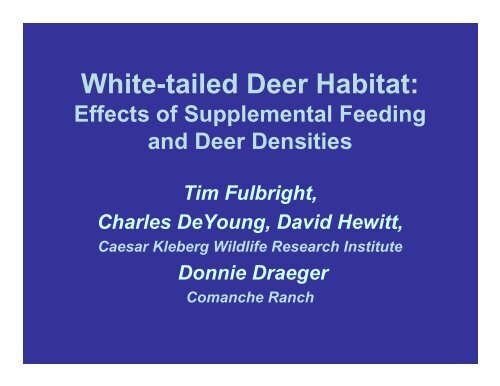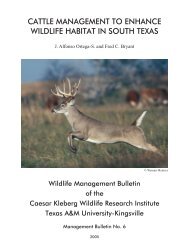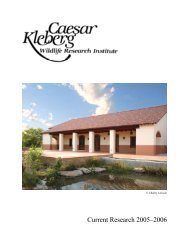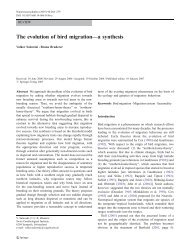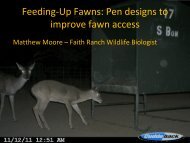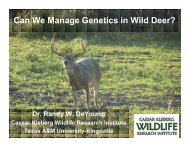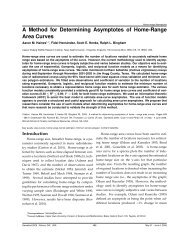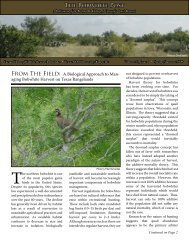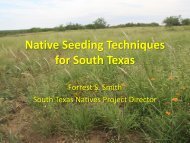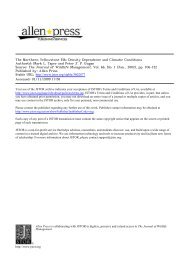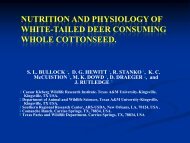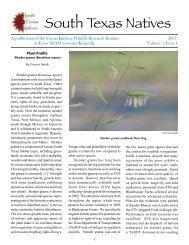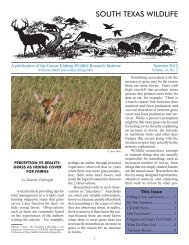White-tailed Deer Habitat: - Caesar Kleberg Wildlife Research Institute
White-tailed Deer Habitat: - Caesar Kleberg Wildlife Research Institute
White-tailed Deer Habitat: - Caesar Kleberg Wildlife Research Institute
- No tags were found...
Create successful ePaper yourself
Turn your PDF publications into a flip-book with our unique Google optimized e-Paper software.
Graduate and UndergraduateStudents• Garrett Timmons• Mark Richman• Aaron Foley• Reagan Gage• Nate Newman• Eric Grahmann• Matthew Moore• Will Moseley• Ryan Darr
Supplemental Feeding• Widespread in Texas• Many landowners maintain high deerdensities
Supplemental Feeding• What is effect of supplemental feeding,high deer densities on habitat?
Specific Questions• Does supplemental feeding allow managersto increase deer densities without harmingvegetation?• What is an appropriate deer density that isin balance with natural forages--with andwithout supplemental feeding?• Does supplemental feeding cause greaterconsumption of highly nutritious “icecream” plants preferred by white-<strong>tailed</strong>deer?
Overall <strong>Research</strong> Objectives• Determine effect of supplementalfeeding, high deer densities on– habitat– deer productivity– population dynamics– nontarget species• 10 year study; initiated in 2003
Experimental Design
Experimental Design200 acres200 acres200 acres200 acres 200 acres 200 acres
Experimental Design• Target densities – 10, 25, or 40deer/enclosure• Represent low, medium, and highdensities for south Texas• Approximates helicopter count of 60,24, and 15 acres/deer• <strong>Deer</strong> added or removed to maintaindensities as close to target as possible
Experimental DesignNot fed10 deerFed10 deerFed25 deerFed40 deerNot Fed25 deerNot Fed40 deer
Measuring Effects on Vegetation• Forb species richness (number of forbspecies/enclosure)• Canopy cover of forbs
Measuring Effects on Vegetation• Canopy cover of woody plants– 1 st , 2 nd , and 3 rd choice• Browse and forb biomass• Stem count index
Stem count indices• Jimmy Rutledge, Ty Bartoskewitz,Daniel Kunz, Alan Cain, Evan McCoy,Kyle Brazil• Estimated % use in Feb and Aug 2004 –2006
• Percentage oftwigs showingevidence ofbrowsingStem Count Index
Supplemental feeding effects:Preliminary results• Forb species richness– similar on fed and unfed• Forb canopy cover and biomass– similar on fed and unfed• Browse canopy cover– similar on fed and unfed
Supplemental feeding effects:Preliminary results• Percent of twigs browsed similar infed and unfed for all 3 browseclasses
Summary of PreliminaryResults• Supplemental feeding– does not appear to increase or decreasefeeding pressure on forbs– does not appear to increase or decreasefeeding pressure on 1 st , 2 nd , and 3 rdchoice browse– does not appear to result in increaseduse of “ice cream” plants
<strong>Deer</strong> density effectsPreliminary results
25Forb species richness2004-2006 average20Species/enclosure151050Low Medium High<strong>Deer</strong> density
25Forb canopy cover2004-2006 average20%151050Low Medium High<strong>Deer</strong> density
120Forb biomass200510080kg/ha6040200Low Medium High<strong>Deer</strong> density
%8765432101 st choice browse canopy cover2004-2006 averageLow Medium High<strong>Deer</strong> density
%353025201510502 nd choice browse canopy cover2004-2006 averageLow Medium High<strong>Deer</strong> density
%4540353025201510503 rd choice browse canopy cover2004-2006 averageLow Medium High<strong>Deer</strong> density
kg/ha350300250200150100500Browse biomass2005Low Medium High<strong>Deer</strong> density
First Choice BrowseBitten (%)50403020100BeforeDensitiesAdjustedLow Medium High**2004-Feb2004-Aug2005-Feb2005-Aug2006-JanSampling date
Second Choice BrowseBitten (%)403020100BeforeDensitiesAdjustedLow Medium High2004-Feb2004-Aug2005-Feb2005-Aug2006-JanSampling date
Third Choice BrowseLow Medium HighBitten (%)3020100BeforeDensitiesAdjusted2004-Feb2004-Aug2005-Feb2005-Aug2006-JanSampling date
Summary of Preliminary• <strong>Deer</strong> DensityResults– Increasing density decreases number offorb species, forb cover, forb biomass– Reduces canopy cover of 2 nd choicebrowse
Summary of Preliminary• <strong>Deer</strong> DensityResults– Trend for heavier use of 1 st , 2 nd , and 3 rdchoice browse species with increasingdensity– Availability of supplemental feed doesnot alter impact of deer on plants
<strong>Deer</strong> response to supplementalfeeding and density• Samples sizes too small to makepreliminary conclusions
<strong>Deer</strong> response to supplementalfeeding and density• Current research:– Productivity: antler size, body mass,reproduction– Population dynamics– Amount of feed in diets using stableisotopes– DNA studies to determine what bucks aredoing the breeding
<strong>Deer</strong> response to supplemental• Questions:feeding and density– If deer density reduces forbs, what is theeffect of this forb reduction on the antlersizes and fawn survival of deer?– Does the availability of supplemental feedalter that effect on antler size and fawnsurvival?
Additional experiments• Feeding effects on raccoons– Home range sizes, movements– Estimates of feed consumption
http://www.tamu.edu/upress/Spanish versionavailable inMarch 2007Amazon (searchfor timothyfulbright)
Unique Features• 1. Deals with managing deer in theleast productive, semiarid portion oftheir range• 2. Compiles information from researchin Mexico and the US• 3. Range management for deer
Chapters• 1. <strong>Habitat</strong> requirements of white-<strong>tailed</strong>deer– Food habits– Sexual segregation– Cover requirements– Home range sizes– Water requirements
Chapters• 2. <strong>White</strong>-<strong>tailed</strong> deer nutrition– Nutritional needs of deer– Energy is the most limiting nutrient– Effects of secondary chemicals inbrowse– Why do deer eat what they do?
Chapters• 3. Ecological Principles Underlying<strong>Habitat</strong> Management– Ecological theory is the foundation ofhabitat management– Responses of deer and vegetation tomanagement differ in semiaridenvironments compared to higherrainfall areas– Importance of plant species diversity
Chapters• 4. Estimating Carrying Capacity– Methods of estimating carryingcapacity– Monitor use of important deerforages
Chapters• 5. Livestock and <strong>White</strong>-<strong>tailed</strong> <strong>Deer</strong><strong>Habitat</strong>– How to manage cattle for optimumdeer habitat– Competition between deer and exoticwildlife
Chapters• 6. Food Plots– How, when, where, and what to plant– How much to plant
Chapters• 7. Brush Management for <strong>White</strong>-<strong>tailed</strong><strong>Deer</strong>– How much brush do you need?– How to design brush management– What methods to use
Chapters• 8. Harvest and Management Planning– Harvest management approaches– Establishing goals– Developing a management plan


